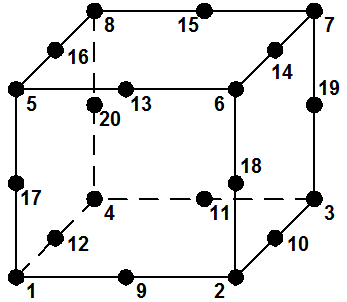Twenty Eight Node Brick u-p Element: Difference between revisions
No edit summary |
No edit summary |
||
| Line 5: | Line 5: | ||
The eight corner nodes have 4 degrees-of-freedom (DOF) each: DOFs 1 to 3 for solid displacement (u) and DOF 4 for fluid pressure (p). The other nodes have 3 DOFs each for solid displacement. This element is implemented for simulating dynamic response of solid-fluid fully coupled material, based on Biot's theory of porous medium. | The eight corner nodes have 4 degrees-of-freedom (DOF) each: DOFs 1 to 3 for solid displacement (u) and DOF 4 for fluid pressure (p). The other nodes have 3 DOFs each for solid displacement. This element is implemented for simulating dynamic response of solid-fluid fully coupled material, based on Biot's theory of porous medium. | ||
'''Please''' [ | '''Please''' [[PressureDependMultiYield02-Example 3 | click here]] '''for examples.''' | ||
Latest revision as of 22:16, 10 August 2012
- Command_Manual
- Tcl Commands
- Modeling_Commands
- model
- uniaxialMaterial
- ndMaterial
- frictionModel
- section
- geometricTransf
- element
- node
- sp commands
- mp commands
- timeSeries
- pattern
- mass
- block commands
- region
- rayleigh
- Analysis Commands
- Output Commands
- Misc Commands
- DataBase Commands
Twenty_Eight_Node_BrickUP is a 20-node hexahedral isoparametric element.
The eight corner nodes have 4 degrees-of-freedom (DOF) each: DOFs 1 to 3 for solid displacement (u) and DOF 4 for fluid pressure (p). The other nodes have 3 DOFs each for solid displacement. This element is implemented for simulating dynamic response of solid-fluid fully coupled material, based on Biot's theory of porous medium.
Please click here for examples.
OUTPUT INTERFACE:
Pore pressure can be recorded at an element node using OpenSees Node Recorder:
recorder Node <-file $fileName> <-time> <-node ($nod1 $nod2 …)> -dof 3 vel
See OpenSees command manual (McKenna and Fenves 2001) for nodal displacement, velocity, or acceleration recorders.
The valid queries to a Twenty_Eight_Node_BrickUP element when creating an ElementRecorder are 'force', 'stiffness', or 'material matNum matArg1 matArg2 ...', where matNum represents the material object at the corresponding integration point.
| element 20_8_BrickUP $eleTag $Node1 … $Node20 $matTag $bulk $fmass $PermX $PermY $PermZ <$bX=0 $bY=0 $bZ=0> |
| $eleTag | A positive integer uniquely identifying the element among all elements |
| $Node1,… $Node20 | 20 element node (previously defined) numbers (see figure above for order of numbering). |
| $matTag | Tag of an NDMaterial object (previously defined) of which the element is composed |
| $bulk | Combined undrained bulk modulus Bc relating changes in pore pressure and volumetric strain, may be approximated by:
Bc ≈ Bf/n where Bf is the bulk modulus of fluid phase (2.2x106 kPa (or 3.191x105 psi) for water), and n the initial porosity. |
| $fmass | Fluid mass density |
| $permX, $permY, $permZ | Permeability coefficients in x, y, and z directions respectively. |
| $bX, $bY, $bZ | Optional gravity acceleration components in x, y, and z directions directions respectively (defaults are 0.0) |
Code Developed by: UC San Diego (Dr. Zhaohui Yang):
UC San Diego Soil Model:
- Element Command
- UC San Diego u-p element (saturated soil)
- NDMaterial Command
- UC San Diego soil models (Linear/Nonlinear, dry/drained/undrained soil response under general 2D/3D static/cyclic loading conditions (please visit UCSD for examples)
- UC San Diego Saturated Undrained soil
- Related References
